From the first flight to supersonic air-travel was achieved in under 50 years. To discover what made it all possible we look at the advances in technology, engineering and materials that were needed, and the social and political pressures that drove the field forward since the first tentative steps toward take-off in the 1870s...
In this episode
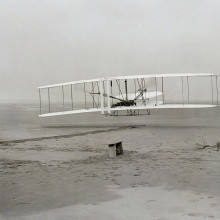
00:53 - From The Birth of Flight to the Great War
From The Birth of Flight to the Great War
with Peter Halford, Imperial War Museum Duxford; Charlie Taylor, Wright Bros. Engineer; Lieutenant Benjamin Folloy, US Army; Jerome Hunsaker, MIT; William Boeing, the Boeing Company;
Ben - Flight had fascinated mankind for centuries: In Greek mythology, Icarus attempted to escape from the Island of Crete on a pair of wings manufactured from feathers and wax; gliding flight was achieved with mixed success as early as 1010AD, and successful balloon flights were recorded regularly in the 1780s. In my search for the birth of modern, powered flight, I visited the Imperial War Museum at Duxford, to meet Peter Halford and find out where to start...
Peter - Well, way back in about 1870, something like that, when steam engines were being experimented with for powering aeroplanes, particularly flapping wing aeroplanes. We've got an example here at Duxford of an engine which was used to power an experimental flapping wing aeroplane. A very small engine, a Becker engine, 5 horsepower. The problem with this, is of course, that not only was it made of heavy materials like cast iron, et cetera, you also had to carry water and fuel as it is external combustion engines so, not particularly successful for aviation.
Ben - So steam engines were not to be the source of power that took us off the ground. But fairly soon, people were taking tentative steps towards take off. The important difference was not so much the design, as the materials...
Peter - Well, the main change was finding materials that would be strong enough, but light enough, so that you get a good power to weight ratio for an aeroplane. We've just had some vintage cars here at Duxford such as Bentleys weighing about 2.5 tons with 200 horsepower engines. That's fine when you're on the ground, but when you want to lift your aeroplane up in the air, it's not going to work. So, that's where the difficulties arise with aviation, not just for engines, but any of the materials and construction methods in an aeroplane have got to be advantageous for power to weight.
Ben - So big changes were afoot - and in 1903, Wilbur and Orville Wright made the first controlled, powered and sustained heavier-than-air flight. A number of factors led to them claiming this hotly contested title...
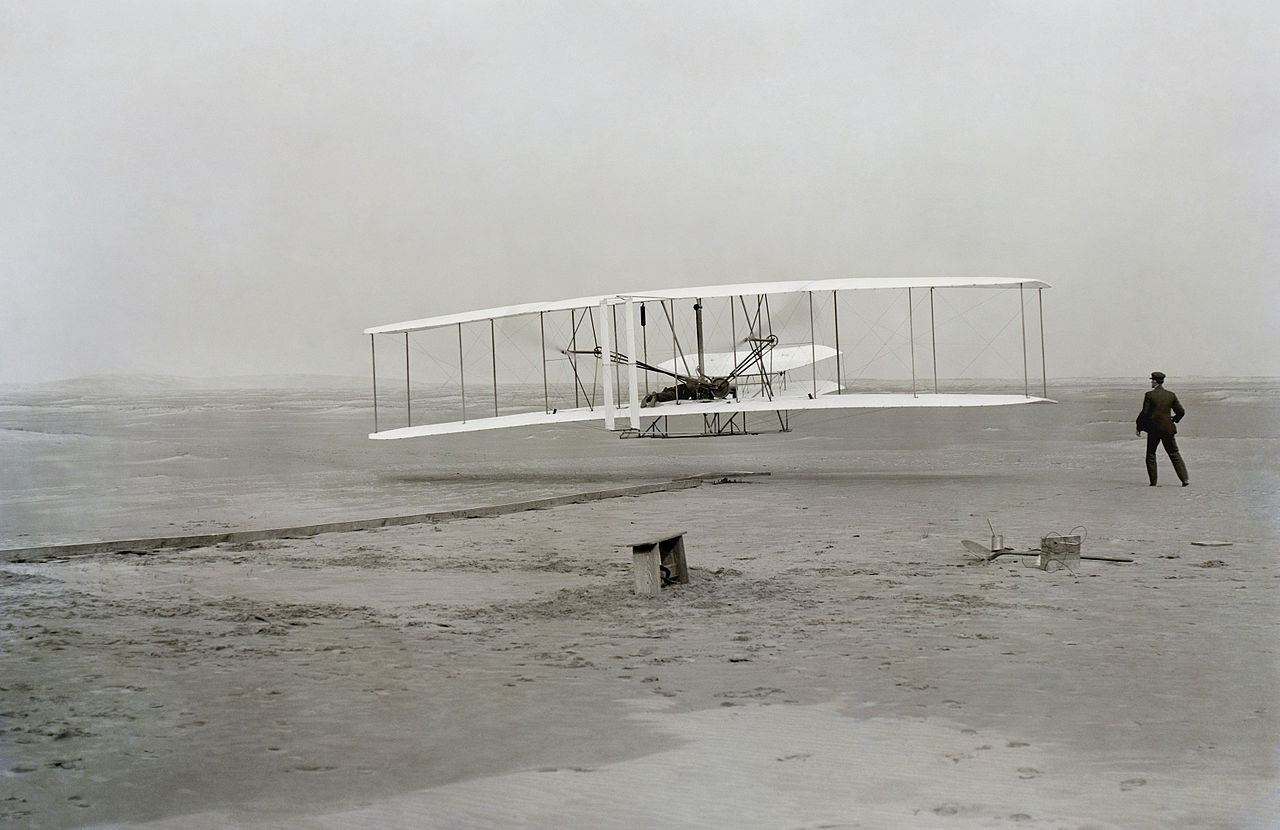 Peter - Well, two things. The official point about this is that they had an independent eye witness and a photograph. Other people at the same time, or around that time, in 1903 were experimenting with similar sorts of ideas, but unfortunately for them and for aviation history, they didn't have the verifiable evidence which the Wright brothers had. But the other thing was that they took from many, many sources, new ideas and technological advances. One thing that they did, they were working with an engineer who developed an aluminium cylinder block. So the materials were really important for this. They could now have a relatively light engine to drive their aeroplane.
Peter - Well, two things. The official point about this is that they had an independent eye witness and a photograph. Other people at the same time, or around that time, in 1903 were experimenting with similar sorts of ideas, but unfortunately for them and for aviation history, they didn't have the verifiable evidence which the Wright brothers had. But the other thing was that they took from many, many sources, new ideas and technological advances. One thing that they did, they were working with an engineer who developed an aluminium cylinder block. So the materials were really important for this. They could now have a relatively light engine to drive their aeroplane.
Ben - In the Early 1960s, The US Army caught up with Charlie Taylor, one of the engineers from the Wright Brother's bicycle shop, as part of a documentary on the History of Aviation...
Charlie - I made all the different parts in the motor, I even made the crankshaft. I made it out of a solid block of steel about 32 inches long, 6 inches wide and 1 inch and 5/8 thick. The motor itself - from the time I started 'til I had it ready for tests - was 6 weeks [work]. Fifty years ago but I can remember it as though it was yesterday almost.
Ben - And it's not just the materials inside the engine that made a difference...
Peter - They were using light woods. The important thing with the wood was thast it was straight grained woods which would be very strong, but needed to be light, and had a fabric covering. And this is where some of the problems with materials begin because if you put a fabric over a wooden frame, you can pull it as tight as you like, but if the atmospheric conditions are wrong, your fabric will become loose, the airflow wont operate properly, so you don't get the lift that you were expecting. The other problem is that you need a very, very tightly woven fabric so that the air won't flow through it, but over it. The Wright Brothers discovered that ladies' underwear was the best material for this purpose. Something called 'Pride of the South' which was a very tightly woven, but not very stretchy fabric. Rather than using lots of ladies' vests sown together, they had large sheets of this made to cover their aeroplane. So, materials of all kinds have been very, very important right from the earliest stages.
Ben - And perhaps it was, at least in part, this reliance on underwear that stopped aircraft from being taken seriously by those who would soon come to rely upon planes - the military...
Peter - The Wright Brothers successful flight was in 1903 and aviation hadn't been on the, to use the modern term, the radar of the military at all. In fact, they were reluctant to embrace the idea, going to the extent of saying, "these are new-fangled ideas", "it'll never catch on", that sort of thing, which is absolutely typical of technological advance. People just say, "Oh no, we do what we did before." Warfare had been conducted in a very similar manner for hundreds, if not thousands, of years. So, the main method of moving things, transport, was animals, particularly horses, mules, et cetera. And that's how things were in the beginning of the First World War. The battlefield was very similar to what it might've been a hundred or more years before.
Ben - The Wright brothers, however, did see the potential in their machines, and set about proving it by showing off and setting world records. Lieutenant Benjamin Folloy joined Orville Wright on one of these "show off" flights in 1908...
Benjamin - On the day following the endurance test with Wilbur Wright, Orville, with a quiet little grin on his face, invited me to be his guest on the crucial and final cross country and speed tests. On July 30th, we took off from the final cross country and speed test. Shortly after we straightened out on the course for Alexandria, Orville, with this same little grin on his face told me that if he had to land anywhere on the route, that he would pick out the thickest clump of trees he could find and land on top of them. Fortunately, the little engine that we had at that time carried us all the way through without any difficulty and we finally landed back on ground with three world records: Cross country - 10 miles. Altitude - 600 feet. Speed - 42.5 miles an hour.
Ben - So what were the Wright brothers doing, erm, right? It was not only the materials, but also their patented control system, and their rejection of flapping wings in favour of the propeller...
Peter - All airplanes have propellers, but there are different types of propellers. The popular understanding of a propeller is what we would now call an airscrew propeller. So, that's the rotating blades on the outside. And the Wright Brothers used that. One of their problems was that their engine wasn't directly connected to the airscrews. They were using chain drive from one engine to two propellers. But the basics of that are the same as the physics for flight in general, using the airflow - air being the fluid, the fluid flowing over surface, and changing direction as something called the Coanda effect takes place. So the air flowing backwards from the airscrew, the reaction to which, as Newton said, was a reaction forwards - thrust. The same thing happens virtually with the aerofoil wing. A curving surface, the air flowing over it and downwards, changes in pressure, and in fact, even now, at institutions such as the University of Cambridge still there is debate about exactly what's happening with the airflow over an aerofoil. But suffice to say, it works.
Ben - These early flights were a good test bed to further our understanding of the physics of flight, which can be simplified to the laws set down by Isaac Newton - Every action has an equal and opposite reaction, so if you can push enough air towards the ground, it will push you into the sky.
Planes normally fly with their nose pointing slightly upward, so for air to get past the angled lower side of the wing it must be pushed downwards, while, due to a phenomenon called the Coanda effect, air sticks to the smoothly curved upper surface, and also ends up being forced downwards - and so the plane is pushed up.
The engineering of flight caught the interest of universities, and soon became an area for academic study. In the United States, the first Aeronautical Engineering department was headed by Jerome Hunsaker...
Jerome - Professional education in aeronautical engineering again in this country at MIT in the winter of 1913 - 14, this course was started by President Maclaurin borrowing me from the navy department and supplying me with one assistant and staff who was a recent graduate in mechanical engineering, Donald Douglas from whom more was to be heard...
Ben - Donald Douglas then went on to establish the Douglas Aircraft Company in 1921, where they designed some of the most significant military aircraft of the 1940s.
Aeroplanes and their engines developed quickly through academic study, as well as the innovations of their designers, who were almost always their pilots. They pushed hard to outdo each other and get further, faster, and higher. But soon, global political events applied a different set of pressures...
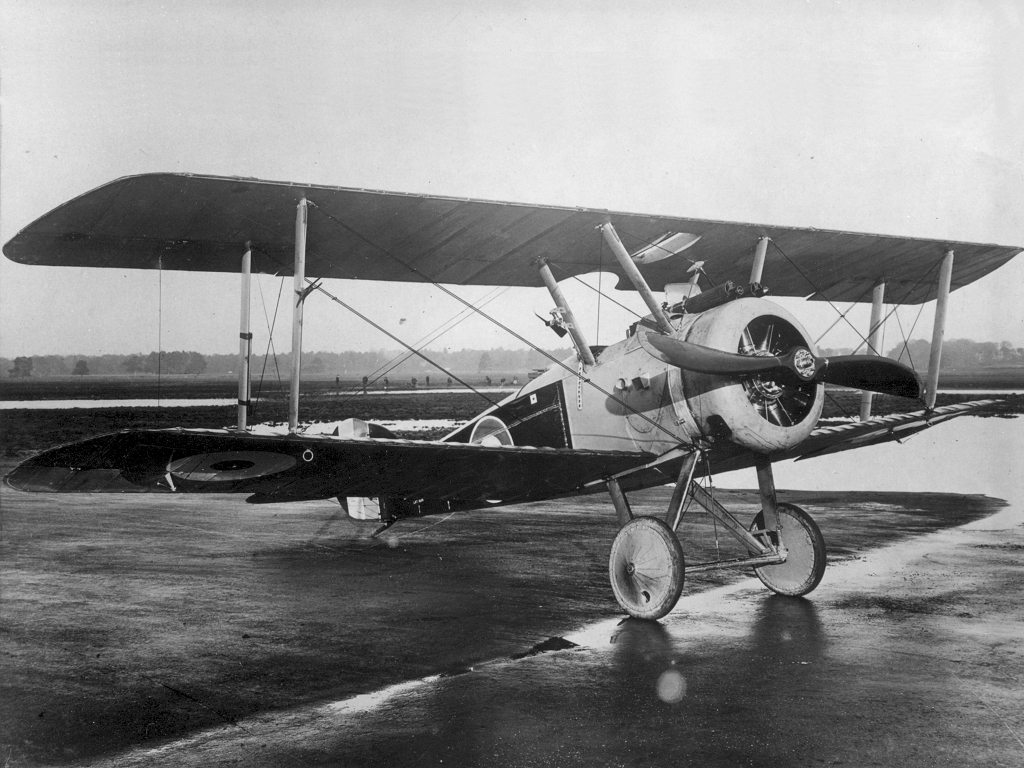 "From a pistol shot in Sarajevo, the first of the great modern World Wars explode. And almost overnight, all of Europe was engulfed in conflict. The aeroplane was put to work as observation and scouting craft. But in the air, alied and German pilots often waved to each other as they passed on their observation missions. Then instead of a courteous wave, the opposing pilots began exchanging pistol fire. Presently, the first crudely mounted machine guns appeared. Now, the frantic race of inventing, improvising, adapting, and refining aircraft equipment began..."
"From a pistol shot in Sarajevo, the first of the great modern World Wars explode. And almost overnight, all of Europe was engulfed in conflict. The aeroplane was put to work as observation and scouting craft. But in the air, alied and German pilots often waved to each other as they passed on their observation missions. Then instead of a courteous wave, the opposing pilots began exchanging pistol fire. Presently, the first crudely mounted machine guns appeared. Now, the frantic race of inventing, improvising, adapting, and refining aircraft equipment began..."Peter - Initially, the use of aircraft in combat was more or less dismissed. But it became apparent that they were going to be very useful for observing what the enemy was doing. The First World War was taking place between two armies facing one another across an almost completely flat battlefield, dug into the ground. Very, very hard to see what the enemy is doing. So, if you can get up above them then you've got an advantage and that's how the thing started, as observational aircraft.
Ben - Throughout the course of the war, many new engines were developed, with different designs, configurations and cooling systems...
Peter - We're standing here in front of the Le Rhône rotary engine, a very small engine, only about a meter wide or so. It rotates around the central shaft. So, the pistons are driving onto the central shaft to drive the airscrew propeller. And the pistons themselves are rotating around. An advantage of this is that of course, they're rotating in the air and they're cooling as they go around. Cooling the engine is very, very important, it always has been. If you can do it using air, then you're reducing the amount of kit you've got to take up with you and so, therefore, reducing the weight and increasing the weight to power ratio advantage. Eventually, engines of this type could get up to about 280 horsepower. Of course, along with the advantages, you also have some disadvantages and the disadvantage is one that it's whirling round and round, and there's oil and things flying about all over the place, and the typical image of a first World War pilot is a blackened face with when he takes his goggles off, just white patches around his eyes. A lot of that has to do with the muck that's coming off of the engine as it's whirling round and round. Another problem, the larger it becomes, the greater mass you're whirling, and the harder it becomes to control your airplane because of the massive torque on here, trying to twist the airplane, so you have to compensate for that. They were extremely popular in the first World War, relatively simple and light in comparison with others. So, the first World War, many, many airplanes [used these engines] and a particularly well-known example would be something like the Sopwith Camel that used the engines of this nature.
Ben - Unlike the Le Rhône's radial layout, the pistons of the Beardmore engine are aligned along the top...
Peter - We're standing in front of an engine from the 1914, the Beardmore engine and this would now develop 120 horsepower. It's a very beautiful looking piece of kit. On the outside, it looks as if it's made of copper and brass and indeed it is. That's the pipe work, copper being a very ductile material, very useful for making pipes, relatively easy to join, so what we can see on the outside is some lovely pipe work and then some water jackets around the pistons. And this of course is where we were talking about the weight problem of having to carry this water to cool your engine. Not only that, but the water leaks out, so there's lots of problems of that nature. One of the points about an inline engine like this one is that its frontal area is relatively small - the larger you get with both radial engines and rotary engines, the larger the surface area at the front is, which creates more drag. Whereas with this one, you can make it a much more sleek and streamlined shape. You've got everything fixed in place so you haven't got this whirling around and round problem. With a smallish engine like this one, the size of it and the length of it is not too great. The more pistons you have and cylinders you have, the longer the engine becomes. And then you have this difficulty of balancing your aeroplane because trim and balance on an airplane is absolutely necessary to get right which again, if you think of a land vehicle, using an engine similar as the one we're looking at, it's not such a big problem.
Ben - Another alternative, helping to pack more power into a shorter engine is to spread your pistons out into a V or W shape...
Peter - So now, we're standing in front of the Napier Lion. The Napier engine was extremely successful. This one is somewhat unusual as it's in what might be called a W formation. Many people will have heard of V-shaped engines, but this one is a W, so it's got cylinders coming in from the top and from the sides. But that means that then you could have a shorter, much more compact, engine but with more cylinders, therefore, creating more power.
Of course, during the first World War, many straight line and V-shaped piston engines we used, but as with other aspects of the war, there's an imperative for doing things and getting things done fast. So, changes were taking place in an enormously rapid pace, much faster than they might have done if it had been completely peace time. And so, the two things that were needed by the military were speed and manoeuvrability. So with a powerful engine like this, you could climb faster, you could outrun your enemies, and so on. So, that's what the quest was for and engines like this were fulfilling that.
Ben - This pressure to provide faster, better aircraft to the war effort led to rapid development and mass manufacture, as well as a vast increase in the numbers of people trained to fly...
Peter - Because there had been that large and quick development, there was also vast numbers of airplanes now surplus to requirement. The First World War was dubbed "the war to end all wars". The hope was that nothing like that would ever happen again. So, these aeroplanes were available. As with anything else - if you get something that goes fast, people want to race each other with them and so, that's exactly what started to happen - air races were instigated. There were even things called flying circuses and that's where aviators went from town to town doing aerobatics and charging people to come and see them. And of course, as soon as they had taken over the old fighters then they start to think, well, we could make this faster and faster, and then from that specific aircraft were being built simply for the speed aspect of things.
Ben - So the end of World War One changed the way we looked at flight and pilots and aircraft designers once more set about the peacetime challenge of outdoing each other. Flight became a commercial enterprise, with flying circuses charging admission to wow the crowds with stunts, and some pilots carrying passengers or delivering packages.
William Boeing, founder of the Boeing Company, piloted the first international commercial airmail service in North America - delivering a parcel from Canada...
William - In 1919, Eddie Hubbard and I took a flight up to Vancouver. On our return trip, the postmaster of Vancouver gave us a mail sack for delivery to the postmaster at Seattle. This was the first international mail ever carried by plane in the United States.
Ben - Back over here in Britain, people had the same idea about making money out of aircraft...
Peter - Another aspect of the surplus airplanes from the First World War was that by the end of First World War, there were some relatively large airplanes, particularly for bombing, and people took those over, removed all the bombing apparatus and so on, and put a few seats in, and they became the first passenger airplanes or transport airplanes, particularly for carrying letters and newspapers to difficult to reach places such as the highlands of Scotland or the islands around Scotland. So, all of that side of things was developing and in fact, of course, something called Imperial Airways began which is still going, it is now called BA.
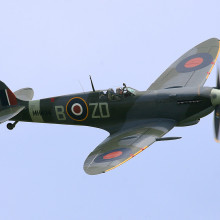
20:33 - World War Two and the Jet Engine
World War Two and the Jet Engine
with Peter Halford, Imperial War Museum Duxford;
Ben - The sudden diversification in the way aeroplanes were being used after the First World War forced engine designers to factor in commercial considerations such as reliability and fuel efficiency...
Peter Halford - It's still the case, to a great extent, with the military, obviously what they're interested in is performance and reliability and all of that, and efficiency and ease of maintenance and so forth is not quite so important. When you come to commercial aircraft then the efficiency and the economics is very, very important. You want to be able to fly your aeroplane as much as possible and make as much revenue as possible so you want it to be very reliable. So, those kinds of things were coming into play as well during the 1920s and 1930s. Of course, precautions are always being taken, defences are really important things, and engines are part of all of that, so things were being developed. But also, of course these engines would be used in other aeroplanes as well.
Ben - So, driven by both commercial interests and the ever-present threat of another war, engines of all types were increasing in power and efficiency...
Peter Halford - This is not so much moving on in time, but development of the engine which has its pistons and cylinders arranged on the outside. This time, not rotating around the central shaft but fixed, driving onto the central shaft along the radii, so it's called a radial engine. It's a Bristol Hercules engine. It would've been used for many different applications, but also in military aircraft and the one we're looking at here could develop over 1,600 horsepower. So we've gone from 5 horsepower to 1,600 horsepower and this is a 1939 engine.
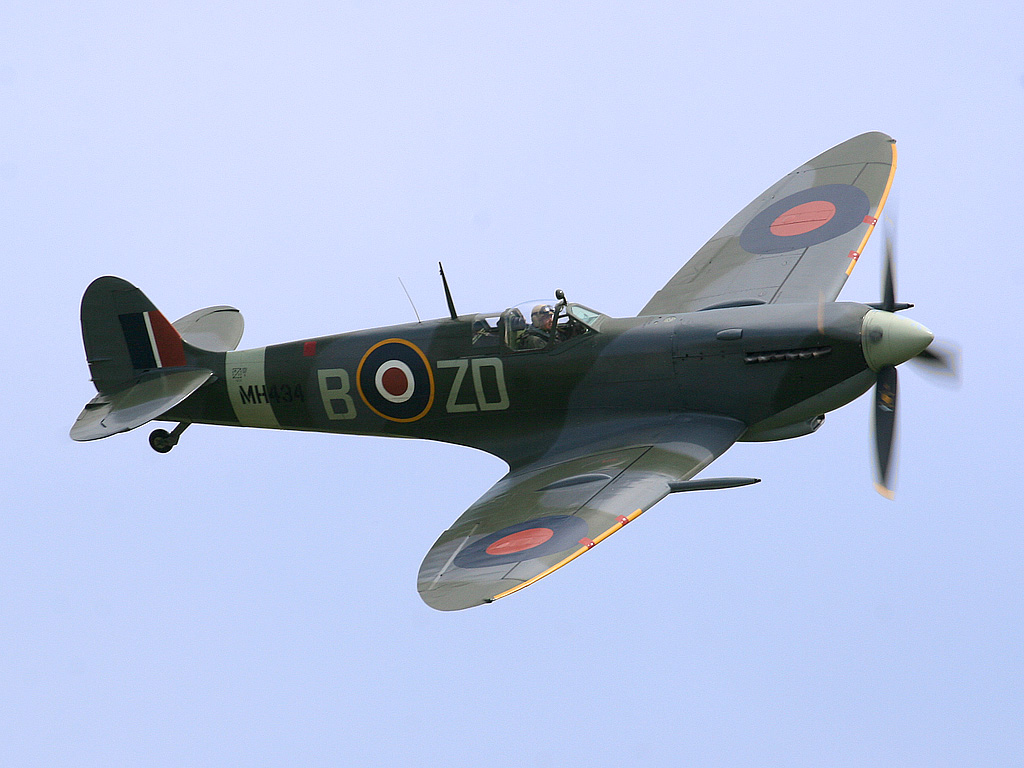 Ben - But it wasn't just the engine design that was marching apace. Almost as soon as man left the ground, engineers were seeking a way to make piloting aircraft easier - by automating as much of the process as possible. These autopilot systems developed rapidly, were demonstrated extensively in the 1930s, and considered important enough to make the national newsreels...
Ben - But it wasn't just the engine design that was marching apace. Almost as soon as man left the ground, engineers were seeking a way to make piloting aircraft easier - by automating as much of the process as possible. These autopilot systems developed rapidly, were demonstrated extensively in the 1930s, and considered important enough to make the national newsreels...
Ben - Aeroplanes and their engines evolved between the wars, refining existing designs into the engines we would come to rely upon in the battles for air supremacy in the Second World War...
Peter Halford - The basics are still the same. This is a piston engine, so with pistons moving up and down in cylinders. The whole thing has been made much more compact, the materials have advanced. There's a lot more alloys, aluminium and so on in an engine like this. It's using the V formation so that you get more cylinders but still in a compact engine. The one we're looking at at the moment is a Rolls Royce Kestrel engine and it led almost directly to possibly the most famous aeroengine that's ever been, the Rolls Royce Merlin.
Ben - An iconic and extremely important engine, the Rolls Royce Merlin first flew in 1933, and went on to power some of the best known planes of the 2nd world war...
Peter Halford - It developed from other engines, a very successful formula, and what happened was that it was continuous development. So, it started off before the Second World War and gradually developed and developed, became more and more efficient, more and more powerful. It was also very versatile in as much as it was small enough and powerful enough to drive fighters such as the Hurricane, the Spitfire, and the American Mustang, but also, it could be used in multiples to drive such large aeroplanes as the Lancaster Bomber. So, it was a very, very versatile engine and it was really the continuous development of it which led to its success.
The materials were developing, particularly alloys, alloys of aluminium and of steel, and so on, things that will withstand the pressures, the temperatures, the vibrations, the rotation and all of that. And when we think back to the earlier engines, it's actually a relatively short time for this development to have taken place. And, notwithstanding the changes in electronics and computers and things in recent times, this is one of the fastest developments of technology that ever been.
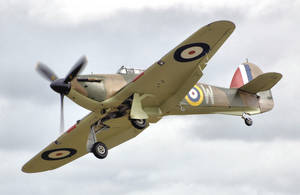 Ben - And it became a decisive development, as the Hurricanes and Spitfires that the Merlin engine powered were deployed in the battle of Britain, regarded as one of the turning points of the 2nd world war. The aeroplanes, and their RAF pilots, garnered new respect...
Ben - And it became a decisive development, as the Hurricanes and Spitfires that the Merlin engine powered were deployed in the battle of Britain, regarded as one of the turning points of the 2nd world war. The aeroplanes, and their RAF pilots, garnered new respect...
Winston Churchill, 1940
Ben - But despite Prime Minister Winston Churchill's memorable speech, and the victory at the battle of Britain, designers of aero engines didn't rest on their laurels. Piston engines were reaching their limits...
Peter Halford - The Second World War was really the first time when major use of air power happened. Not only in fighting with small fighters such as Spitfires and Mustangs, and Messerschmitts and so on, but also, aerial bombing - a tremendous amount of that. So we have very, very large aeroplanes like the one we're standing right close to me now, the famous Lancaster Bomber. So then you're requiring very, very large aeroplanes, very powerful for very, very large payloads, and as with any other conflict, it's a race between one power and the other so, as one set of aircraft from one air force was developing then the others had to develop, and so on. A lot of it was in place beforehand and it was just that continuous and rapid development that we mentioned with the Merlin, for instance, which took place throughout those very brief, but very, very significant few years. This brought us eventually to having really enormous engines such as the Napier Sabre engine which really represents the top of the chain as far as piston engine is concerned - the optimum. So, it could then develop up to 3,000 horsepower, but then you get a very, very large heavy engine weighing itself about a ton and with a large surface area and so on. So after that, you're going to compromise the power to weight ratio so much that you can't go much further which is where you need another form of power entirely.
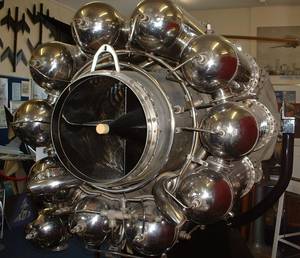 Ben - So with an imperative to find new ways to increase the power to weight ratio, a new type of engine had to be designed...
Ben - So with an imperative to find new ways to increase the power to weight ratio, a new type of engine had to be designed...
Peter Halford - Well, there'd already been something there. In fact, there had been an idea for thousands of years that the Greeks had known about and this is jet propulsion. In fact, the first successful jet aeroplane flew in 1910. When you consider that the Wright Brothers only flew the first successful powered aeroplane in the 1903 that is not very long afterwards. This was called the Coanda 1910, imaginatively, by Henri Coanda. He used a piston engine to compress the gas and he unfortunately had the Coanda effect named after him because he discovered it by mistake when the hot gases from his engine flowed along the fabric sides of his aeroplane and set it on fire. Luckily for him, he jumped off and was safe, but of course, nobody would back him any further so his idea was lost for a time. However, it was re-taken up and successful Coanda jet aeroplanes were flying in the 1940s and afterwards. However, in the interim, another method had been discovered and developed particularly here in this country by Frank Whittle and over in Germany by an engineer called Hans von Ohain and that was the gas turbine. And when you combine a gas turbine with a jet, you have the gas turbine jet propeller, and that's where things moved on to, and that's where we are today.
Ben - Looking from the outside, the jet engine appears to be a completely different design to the airscrew propellers that we were used to. But what about the physics behind it?
Peter - Well, the basic physics is just the same because you need something going in one direction, so an action, and a reaction in the other direction. In many ways, it's very similar because you would use rotating blades. But this time, you put the blades inside the engine rather than on the outside. So, an airscrew propeller is on the outside and a gas turbine jet propeller has the blades on the inside. You then compress the gas, the air that is, and you mix it with a fuel, and that becomes a highly volatile compressed gas. You set fire to it, it goes bang and expands, and blows out the other end, creating the force that you need to push it along. The simple explanation of that is that you suck the air in, you squeeze it down, you make it go bang and it blows out of the back. So it is suck, squeeze, bang, blow - really simple. But of course, the difficult part is the engineering and the engineering depends very much on the materials because now, you're going to have something that's going to not only withstand those heats but also enormous pressures, lots of rotation and so on. So, developing those materials or finding suitable materials was one of the most difficult parts of the exercise.
Ben - Peter Halford from the Imperial War Museum at Duxford.
creative commons attribution licence by
Fight2FlyPhoto, and captioned: "This is the sound of a Supermarine Spitfire Mk Vc with a Rolls-Royce Merline followed by a Spitfire Mk. IXe with a Packard Merlin."
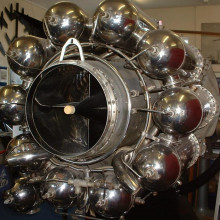
32:08 - How a Jet Engine Works
How a Jet Engine Works
with Professor Jim Wickerson, Rolls Royce
Dave - How do jet engines actually work? One simple way to think about it is Suck, Squeeze, Bang, Blow. The engine sucks air in the front, compresses it, adds fuel which burns, expands and is blown out of the back, producing thrust and pushing the plane along. To get a more detailed idea of the physics behind the jet engine, I went along to the Heritage Museum of jet engine manufacturer Rolls Royce in Derby to meet Professor Jim Wickerson...
Jim - We are in the business of creating thrust. We want to get hold of air, throw it behind the engine, and as we accelerate it out of the back of the engine we're going to have a reaction force. That reaction force is going to push the engine through the sky. The engine is attached by pylon to the aircraft. So in the action of pushing the engine, we're going to pull the aircraft through the sky. An aircraft wouldn't move without being pushed.
Dave - So this is essentially very, very basic physics, Newton's second law.
 Jim - There is more to it than that but Newton is a very good start. In order to accelerate this air through the engine, you have to apply a force to it. The thing which is applying a force to this air to accelerate it out of the back of the engine is the engine itself, and then Newton said in his laws that if you apply a force to something, the air, then the air will apply an equal and opposite reaction to the mechanism which is doing this, and that mechanism is called an engine. And then provided we attach the engine by struts which are strong enough to do the job, but not too heavy, then this engine would pull the aircraft through the sky, and that sort of engine is called a gas turbine engine.
Jim - There is more to it than that but Newton is a very good start. In order to accelerate this air through the engine, you have to apply a force to it. The thing which is applying a force to this air to accelerate it out of the back of the engine is the engine itself, and then Newton said in his laws that if you apply a force to something, the air, then the air will apply an equal and opposite reaction to the mechanism which is doing this, and that mechanism is called an engine. And then provided we attach the engine by struts which are strong enough to do the job, but not too heavy, then this engine would pull the aircraft through the sky, and that sort of engine is called a gas turbine engine.
Dave - I guess virtually any aeroplane engine must work on this basic principle because there's nothing else to push on in the sky other than air. So what actually is special about the gas turbine, what we normally call a jet engine?
Jim - The special feature is the higher speed jet which lets us fly faster. So how does it work? What we have available is fuel. Fuel, kerosene, is a very condensed form of energy and we can convert the fuel to this fast moving jet which is going to give us thrust. We then have what's called a heat engine. Car engines, those are heat engines. There's jet engines, those are heat engines. What they do is they take the fuel and they burn it. If you did that burning at ambient pressure we would be stuck with the thermal energy, we've burned fuel we've now got some hot air, and all we'd have done is heat the house or heat the room. The characteristic of all jet engines, car engines, piston engines, whatever, they first of all have a compression stage where the air comes in and gets squashed. We then have a combustor where we burn the fuel and then having squashed first in the compressor, we can then expand the combustion products through turbines which drive compressors and then out through the back of the engine. Because we're expanding, we're getting cooler and we're converting some of the thermal energy we created in combustion to the thing we want - work to drive compressors and work to accelerate a jet out the back.
Dave - So is it essentially easier for the air to get out through the turbines at the back of the engine than back through the compressor forwards?
Jim - The air has first of all got to be squashed. If we don't squash the air before we do the combustion process, we'll never later on be able to expand the air and convert some of the thermal energy we've built up by combustion to something useful, so we must squash it first. We have the rotors and stators, these air foils of this axial compressor pushing the air up the hill of pressure. We then have a burning phase where the gas stays at the same pressure but gets much hotter. We then drop the air down through the turbine, we're dropping pressure through the turbine. If you give any gas a pressure drop then it's going to experience a force to accelerate it. If pressure is dropping, the air is going to go faster into the place of lower pressure. So we have a pressure drop through the turbine and in that pressure drop, the gas goes faster. The fast moving gas is aimed through nozzle guide veins at moving turbine blades. The fast moving gas pushes the turbine rotor blades, and they're connected by a shaft to drive the compressor. Now why is the gas going in that direction? Because there's a pressure drop. If there's a pressure drop, the air will follow the direction of the pressure drop. So we're now dropping pressure through the turbine, the air is accelerating, pushing turbines, driving compressors.
Dave - So why is the pressure actually dropping as you leave the engine?
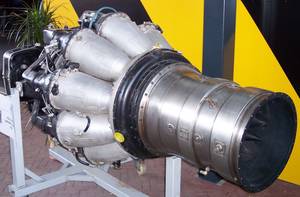 Jim - Well, the pressure drops twice. There's a pressure drop through the turbine - the turbine is the thing which drives the compressor - then there's another pressure drop through the nozzle. Why do we have pressure drops? Because we have to. You can't get something going fast to then push against the turbine unless there's a force. The pressure drop multiplied by the flow area is the accelerating force, so we must have a pressure drop through the turbine to get the very fast moving flow which pushes the turbine. Now, the way we get a lot of force on one turbine, so we don't need many turbines, is by having the gas going very fast. Typically, through a Rolls Royce 'Trent' engine at take off, we've got 200 kilograms a second of core flow. We accelerate that 200 kilograms of core flow to 1000 litres a second, or 2000 miles an hour. As we get that fast moving flow, we impact it onto the turbine blades, and as we turn through the turbine we get a lift force of about 20 tons, so that's a large force on one turbine so we don't need many turbines to drive the compressor. They actually travel at the speed of sound, these turbine gases, and it's the speed of sound in a hot gas. You may know that the speed of sound in air is 330 meters per second. We've got a hot gas, so the speed of sound is three times as much, so we're travelling at about 1,000 metres per second, so that fast moving flow would only go fast because there's been a pressure drop.
Jim - Well, the pressure drops twice. There's a pressure drop through the turbine - the turbine is the thing which drives the compressor - then there's another pressure drop through the nozzle. Why do we have pressure drops? Because we have to. You can't get something going fast to then push against the turbine unless there's a force. The pressure drop multiplied by the flow area is the accelerating force, so we must have a pressure drop through the turbine to get the very fast moving flow which pushes the turbine. Now, the way we get a lot of force on one turbine, so we don't need many turbines, is by having the gas going very fast. Typically, through a Rolls Royce 'Trent' engine at take off, we've got 200 kilograms a second of core flow. We accelerate that 200 kilograms of core flow to 1000 litres a second, or 2000 miles an hour. As we get that fast moving flow, we impact it onto the turbine blades, and as we turn through the turbine we get a lift force of about 20 tons, so that's a large force on one turbine so we don't need many turbines to drive the compressor. They actually travel at the speed of sound, these turbine gases, and it's the speed of sound in a hot gas. You may know that the speed of sound in air is 330 meters per second. We've got a hot gas, so the speed of sound is three times as much, so we're travelling at about 1,000 metres per second, so that fast moving flow would only go fast because there's been a pressure drop.
Dave - So your gas turbine is using this immense amount of power. Even on a plane, are you just extracting that by the air accelerating out the back of the jet itself.
Jim - Okay, well that takes us on very nicely to turbo jets and turbo fans. What we've talked about so far has been a turbo jet, but in the 1960s, we invented the turbo fan. We add a low pressure turbine downstream of the first turbine. That low pressure turbine drives a huge fan at the front of the engine. The huge fan builds up a little bit of pressure with a lot of air, and throws a large mass back at a low velocity. Having gone through the low pressure turbine, the core air has used up most of its spare pressure, and again, just pops out at a modest velocity. So we've added complexity, we've added cost, we've added weight, we've added engine drag, but we've doubled or tripled the amount of thrust for a given amount of fuel, and hugely reduced the noise because jet noise goes with jet velocity to the 8th power. So as we drop the jet velocity, the noise plummets. If you've ever been sent to listen to a A380 taking off on a radio program, you'd get into a mess because they're so quiet, you can't hear them.
Audio clip provided by Michael Manzke.
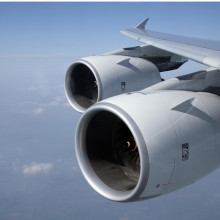
39:09 - Materials Maketh the Jet Engine
Materials Maketh the Jet Engine
with Professor Dave Rugg, Rolls Royce
The extreme conditions inside the jet engine presents a real challenge for engineers and designers, and they need to be able to rely on specially developed materials that can handle that environment whilst still being light enough to get aloft. Professor Dave Rugg, also at Rolls Royce walked me along the enormous Trent engine to explain the materials that go in to its manufacture.
Dave - Okay, at the front end, we sometimes have aluminium in small quantities and that can be for statics around the case, but largely it's titanium at front end. Titanium is king there. It's got very high strength : weight ratio, very, very good corrosion resistance as well so you don't get problems with salt water and all kinds of other aggressive environments that you might have. So over the years, titanium has actually worked its way back through the engine to progressively higher and higher temperatures. In the Trent series, it makes its way all the way through to the high pressure compressor assembly. And there, the temperatures can be in excessive of 600 centigrade.
Ben - And these are quite big components of the Trent, so presumably the pressure to use titanium is to cut down on weight?
Dave - Absolutely. Titanium has a got a density of about 4.5 gr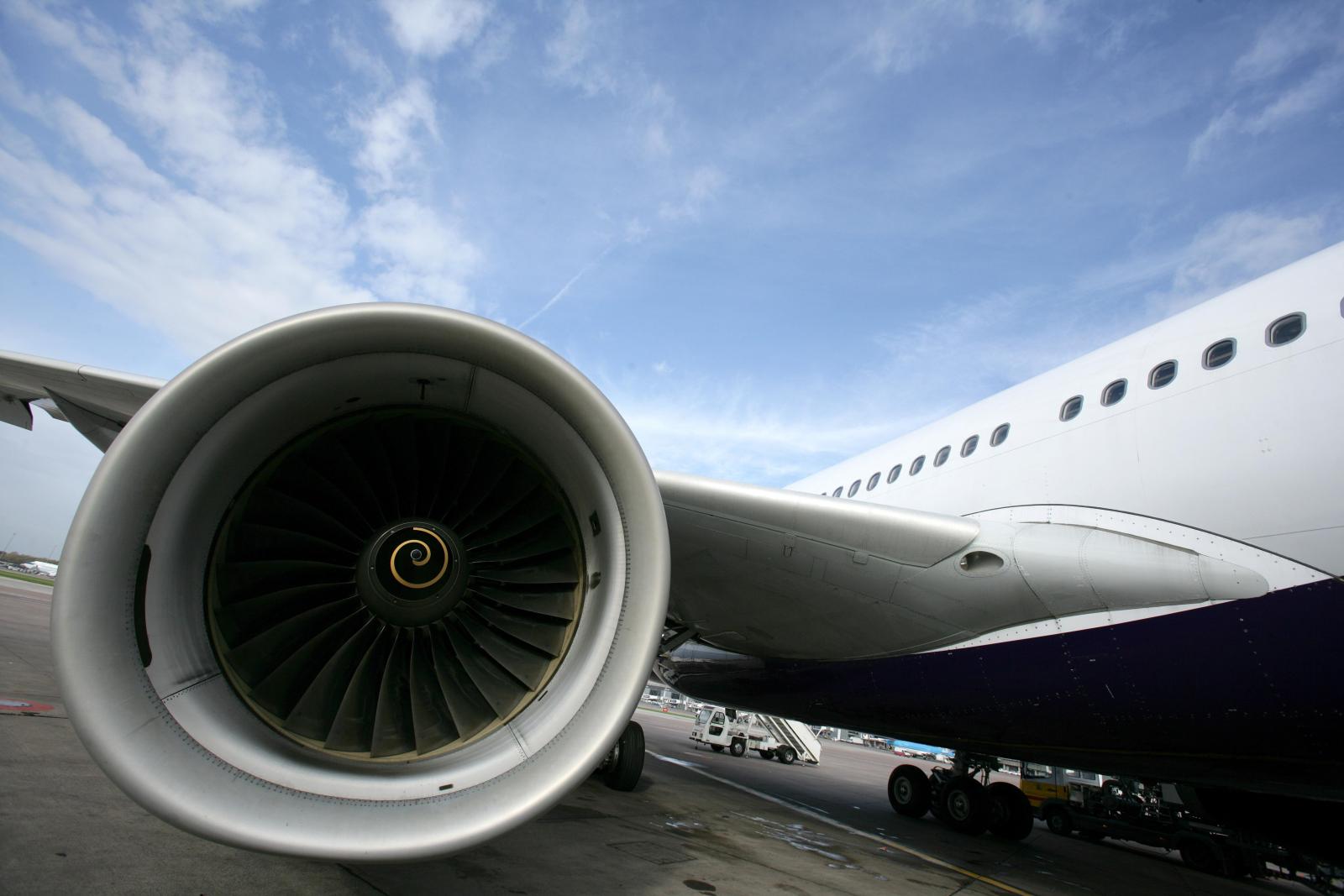 ams per cc whereas nickels and steels will be up in the 7 and 8 so, big saving on weight there. And the benefit is both in terms of the actual mass of the entire engine, but also then the stresses that are induced on the rotating power it's because obviously, we've got self-induced loadings from the centrifugal force. We also should mention that containment case around the fan and again, that's titanium used for its high strength capability and it's also very good under high strain rate loading. So, quite a remarkable structure and very large as well as you can see.
ams per cc whereas nickels and steels will be up in the 7 and 8 so, big saving on weight there. And the benefit is both in terms of the actual mass of the entire engine, but also then the stresses that are induced on the rotating power it's because obviously, we've got self-induced loadings from the centrifugal force. We also should mention that containment case around the fan and again, that's titanium used for its high strength capability and it's also very good under high strain rate loading. So, quite a remarkable structure and very large as well as you can see.
Ben - Is this not the region of the engine where we're starting to look at using more and more composites as well?
Dave - That's absolutely right and the main reason for composite materials, they're both stiff and they're very light so we get improved weight saving over titanium although engineering and composites provides its own challenges as well. So, as we move back a little bit further, you see here, we've got a lot of accessories which people tend to try and ignore, but in reality, things like gearbox casings, a lot of cast light alloys, so there'd be aluminium. In some of our engines, we actually use magnesium alloys as well - very, very light, also, good resistance against vibrations so they naturally damp vibrations which is quite important.
Ben - I understand one of the problems with magnesium alloys is that they oxidise quite readily, so presumably, these are regions where either oxidation wouldn't be as big a problem or where they're a bit more shielded.
Dave - That's correct. They're in relatively cool environments, so you've not got you're high temperature oxidation concerns. The magnesium industry has been active in developing new alloys as well and the types of materials, we use a typically very high purity magnesium alloy so they minimise the use of introduction things like iron or copper which even at trace levels will badly affect corrosion resistance. And the other thing as you can see is we have very good surface treatment systems so that we don't get problems with corrosion, also galvanically insulating the magnesium components is beneficial so that you don't get battery on the side of your engine.
Ben - So, the front of the engine needs to be extremely strong while also being very light. So alloys of titanium and aluminium fit the bill. These components are responsible for the suck and the squeeze, taking the air in a compressing it. Once we get into the fuel burning region of the engine where the bang takes place, conditions are radically different.
Dave - Now, we're heading through into the back end of the compressor where we start to see nickel alloys coming in and they're pretty remarkable materials in terms of their strength retention at temperature which is why we're using them, so very good resistance against creep and the combustion chamber where again, it's nickel alloys that earn their money. The other thing you see in here is lots and lots of pipes. They can be in a variety of different materials but again, a lot of nickel used and some stainless steels as well.
Ben - So the real challenge in this bit of the engine is coping with that heat.
Dave - Absolutely. It's very high temperatures when you're burning kerosene basically under very high mass flows. So, the centre of the engine is white hot.
Ben - To cope with operating with huge stresses and very, very high temperatures, new alloys, single crystal components and high precision manufacturing technologies are employed. Meeting these demands drives the understanding of material science at universities worldwide. But even behind the white hot part of the engine, there's still work to be done.
Dave - The turbine has two main jobs to do. The first one is simply extracting the energy from the mass flow of the combustion products coming over it. So we use the turbine to both power the compressor assemblies to make the system work at all, but then we use the back end of the turbine to actually power the fan and it's the fan that provides around about 75% of the engine's thrust. An HP turbine blade which is about the size of a matchbox roughly, a bit thinner obviously, extracts getting on for 1000 horsepower's worth of energy from the gas stream which is quite incredible if you think - that's the entire energy output of the Merlin being taken by one small blade, the size of a matchbox.
Ben - But even the best high performance alloys such as those that make up these turbine blades couldn't be expected to work well in conditions above their melting point, so engineers have come up with incredibly complex and clever cooling vents and other systems that play a vital role.
Dave - Absolutely. If you try to just use monolithic nickel alloy in the turbine even on most advanced materials, they would just melt immediately. It would be fractions of a second and you have a molten puddle which wouldn't be very good. So, we have to use cooling for them and it's pretty amazing to think that the cooling gas that we use is actually several hundred degrees centigrade. The analogy that I've heard is that it's - with turbine blades, it's a bit like trying to use components in an oven that are made out of ice.
Ben - Reaching the very back of the engine, the vent itself is far more than just, act as an enormous exhaust pipe.
Dave - That's exactly right. As I said, the LP turbine provides a power to the fan, but some of the key jobs in turbine design for the low pressure turbine are to ensure you get very good mixing between the bypass air and the combustion products coming out of the back of the engine because if that isn't done correctly, the noise levels can be very substantive and clearly, there's a large number of reasons why we want to keep the engines quiet.
That was Dave Rugg, from Rolls Royce, for whom noise reduction is a priority. I met their Senior Project Engineer for Noise, Joe Walsh, and their Chief Noise Specialist, Andrew Kempton.
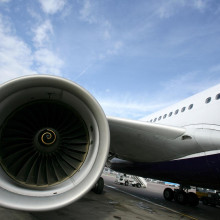
46:00 - Turning Down Take Off Noise
Turning Down Take Off Noise
with Andrew Kempton & Joe Walsh, Rolls Royce
Dave - So far, we've heard how aircraft can impact on weather. There is also a major impact much closer to the ground and that's noise. As air traffic grows, it's becoming an increasingly important problem. So to find out what manufacturers are doing to solve the problem, Ben Valsler has been to speak to Rolls Royce's Senior Project Engineer for Noise, Joe Walsh, and their Chief Noise Specialist, Andrew Kempton.
Andrew - Aircraft noise has been a problem since the introduction of jet-powered aircraft in the late 1950s, early 1960s. It can be a serious problem for those living close to airports and it restricts airport growth, and the growth of aviation because of high noise levels.
 Ben - So what's actually causing the problem? Is it the engines? Is it the movement of the aeroplanes themselves? What are the issues that we need to focus on to try and solve this problem?
Ben - So what's actually causing the problem? Is it the engines? Is it the movement of the aeroplanes themselves? What are the issues that we need to focus on to try and solve this problem?
Andrew - Engine noise has been the principal culprit, but over time, the noise levels we've managed to reduce significantly from the engine, so that means that other noise sources on the aircraft are now becoming to be serious concerns. The noise of the air frame itself without engines, the noise of the aircraft as a glider, is a significant contributor to the noise when the aircraft is coming into landing.
Ben - So taking the engine itself, what is it about that engine that creates so much noise?
Joe - Well when you consider that the engine is providing thrust for the aircraft and the way it does that is to suck in air, accelerate and pressurise it, and exhaust it. That provides the forward thrust, so one of the sources of noise is created by the air exhausting, creating turbulence, creating noise. But as engine designs have developed, we've gone to larger fan diameters which suck in more air, exhaust the air more slowly, and so, generate less noise which is good, but also, the fan is there creating noise in its own right. So although the overall noise is reduced, we now need to consider noise from the fan and other, what we call turbo-machinery components, and find ways progressively to reduce those noise sources.
Ben - Jet engine designs have changed over the last 50 years presumably with the main aim to get more power for less fuel, and be able to lift more weight, and stay in the air for longer. Has reducing noise been a consideration throughout that development?
Joe - Yes, entirely. We've had a significant effort into noise reduction at Rolls Royce for many years, as have the other engine manufacturers, and the aircraft manufacturers. And although we've been quite successful in achieving significant noise reductions, there's still more to do. So the effort will continue, but the nature of the challenge is changing. As we've progressively reduced the traditional noise sources, other noise sources come along and we need to continue to address those, looking at the problem as a total system problem.
Ben - So, as well as the inevitable noise of having to push a lot of air backwards quite quickly, what other parts of jet engines make noises? What other designs can we put in place that can cut down some of that noise?
Andrew - The fan noise which is generated by interactions between the fan and hardware behind it can be reduced by careful design of the fan, where we're using computational methods, very big computers to assess what noise is created and to minimise that, at the same time as insuring the fans are very efficient, but we also have acoustic liners which we line the ducting of the engine which help to absorb the sound.
Ben - So it's not just about reducing the sounds that are created in the first place, but it's about managing how they then travel away from the engine so that we can reduce how much actually gets out into the environment.
Andrew - Yes, and there are even some designs which try to use the air frame itself to shield the noise coming from the engine to ensure that that noise doesn't get down to the communities around airports.
Ben - What difference have we been able to make so far?
Andrew - Well only a small amount of the energy in an engine actually comes out as noise. My university professor used to tell me that the noise of an FA Cup final crowd was enough to fry one egg, and the energy that's in the engine is very, very much more than that. We have been able to reduce the noise by 99% or 99.9% over the last 30 or 40 years, but unfortunately, the human ear does not respond linearly to changes in acoustic energy that's reaching it. So, although we've reduced the sound power to 0.1% of what it used to be, this is only represented by perhaps a factor of 8 reduction in annoyance for people listening to the aircraft. But considerable strides have been made and work is continuing to drive down noise further.
Ben - I imagine that there are other things that we can try and do. For example, make the engines powerful enough to take off very quickly or to perhaps reduce the length of runway that they need so that actually they're closer to the ground for less time. Is this something else that we consider as well as the noise that the machine itself makes?
Joe - Yes because ultimately what we're trying to do is reduce the annoyance received on the ground and there are many factors which cause annoyance, not only the sound intensity but also the character of the sound; What frequencies are present? How long does the noise last for? So when you're considering how to mitigate those things, factors such as aircraft performance, thrust required to take the aircraft off the ground, are all variables, and they're considered as part of the initial designing concept evaluation to look at the most effective way of meeting all of the aircraft requirements and all of the engine requirements including reducing noise.
Ben - I assume that everything has to be a bit of a compromise. We can't purely aim for a very quiet engine that actually produces a huge amount of CO2, and likewise, we can't aim for a super efficient engine that will deafen people nearby.
Joe - Yes, design trades are involved. It's useful sometimes to look at what it would take to design a very quiet engine. So we were involved with some work called the Silent Aircraft Initiative, and that looked at what it would take to design a functionally quiet aircraft that would be imperceptible above typical background urban noise levels. That aircraft looked a bit like a flying wing. It had exceptionally low projected noise levels. It had significant technical challenges associated with it, but in terms of an extreme design, it did show that measures could be taken to generate very low noise levels. However, there was a downside. The downside is that the lowest noise design doesn't coincide with the best performance design. So inevitably, there is some balance required and what we're looking to do is to achieve low acceptable noise levels whilst designing an aircraft which meets many other requirements - operational, safety, economic, emissions, chemical emissions as well, and we're part of that design trade, and we're developing noise technologies that allow the best possible progress on noise reduction whilst allowing progress to also be made on other attributes.
Dave - That was Joe Walsh and before him, Andrew Kempton, both from Rolls Royce speaking with Ben Valsler.
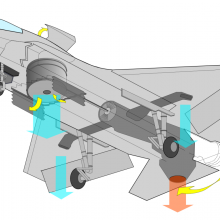
53:32 - Jumping Jets! - The Joint Strike Fighter
Jumping Jets! - The Joint Strike Fighter
with Neil Mehta, Rolls Royce
Jet engines, and the planes that they power, are under constant development. There are commercial pressures to make them quieter, more powerful and more fuel efficient, as well as pressures from the military for speed, manoeuvrability and stealth.
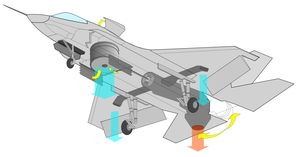 One major change has been the development of Vertical Take off and Landing (VTOL) or Short Take Off and Vertical Landing (STOVL). This ability, probably best known from the Harrier Jump Jet, makes it easier for military aircraft to launch from, and land on, naval aircraft carriers.
One major change has been the development of Vertical Take off and Landing (VTOL) or Short Take Off and Vertical Landing (STOVL). This ability, probably best known from the Harrier Jump Jet, makes it easier for military aircraft to launch from, and land on, naval aircraft carriers.
The newest generation of STOVL aircraft, the Joint Strike Fighter or JSF programme, has at its heart a Lift Fan designed by Rolls Royce. I spoke to Neil Mehta, programme director for the JSF Lift system...
Neil - We've taken the Harrier concept that we developed here at Rolls Royce, taken their best ideas and built on top of those really and to give an aircraft now which is supersonic. It is fully stealthy which means it can't or it's very, very difficult to be seeing through a radar and has a much bigger load bearing capacity and range than the original Harrier.
Ben - So how do you make an aircraft take-off as if it were a helicopter straight up?
Neil - Well, the hover part, the vertical thrust part comes from the lift system and the lift system is made up of 4 different modules. The first one is the lift fan and the lift fan is kind of like the front part of a traditional turbo jet but it pops through 90 degrees. So it will suck air from the top of the aircraft and blow it out at high pressure at the bottom of the aircraft through a vain box which allows that flow to be directed. And that gives about 20,000 pounds of thrusts and creates one of the 4 legs that keeps the aircraft in the air during a hover. At the back of the aircraft, we direct thrust from the main engine through 90 degrees when we're in hover, through a module called a 3-bearing swivel duct. And this is a fantastic piece of equipment. In normal flight, it will point backwards, in hover, it will point down and it can transition between one and the other in under 2 seconds and turn 20,000 pounds of thrust through that angle. So that's two of the legs and between those two legs, they take the most of the weight to the aircraft. But then roll control would stop the wings dipping up and down. Embedded in each of the wings is a roll post duct which bleeds air off the main engine and creates two, much smaller jets of air, really to give the roll control on the aircraft. So effectively in hover, the aircraft's balanced on four pillars of air - one from the lift van at the front of the aircraft, one from the 3-BSM at the back of the aircraft, and then one on each of the wings.
Ben - So, taking the fan itself, how does that compare to a jet engine? You said it's like the front part of it, but we know that jet engines work. Could you not just put a jet engine rotated through 90 degrees and use that for your thrust?
Neil - Certainly, some of the concept studies around the world did just that, but ours is a much simpler and refined design. The power from a jet engine comes from burning fuel and running it through a turbine which then drives the fans and the compressors at the front end of the engine. Instead of having the fuel and turbines in the lift fan, we actually take through a shaft and a clutch in a gearbox arrangement, we take that power off the main engine. So the very same engine that would power aircraft when it transitions into normal flight. So that means we don't need a duplicate turbine, we don't need a duplicate fuel system, we don't need a duplicate combustor which all adds weight and cost, and would take up a lot of room in the aircraft. So, our concept is really the only feasible concept for this type of aircraft.
Ben - I assume that because you don't have the complications of say, the extreme heat inside the jet engine, that means that actually, the materials you put in the lift fan can be optimised to be even lighter and even better doing that lifting, without having to worry about functioning in extreme conditions.
Neil - It's true on the lift fan that we don't have extreme heat conditions although that can't be said of the 3-BSM which is at the back of the main engine. However, we put the lift fan through some pretty extreme conditions. We are always mindful of the weight thrust balance in there, and aerodynamically as you might imagine, having an engine at 90 degrees to the airflow rather than directly on, poses some incredible challenges to our aerodynamicists.
And to cope with flying it around about 250 knots with the engine at 90 degrees to it has required us to push our computational fluid dynamics and understanding of aerodynamics to a next level. We operate in areas that no other aircraft or no other blade would operate in.
Ben - Neil Mehta, Programme Designer for the JSF lift system. And that brings us right up to the present day, but engines in aeroplanes are still in constant development. The new alloys and composite materials being designed in universities across the world will pave the way for new types of jet and push that current limits even further, keeping us flying into the future.
- Previous Finding Impossible Stars
- Next What causes anencephaly?









Comments
Add a comment